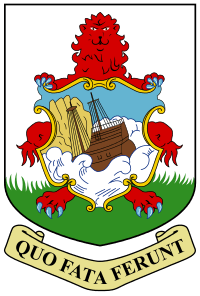Bermudian English

Bermudian English is a regional accent of English found in Bermuda, a British overseas territory in the North Atlantic. "Standard English is used in professional settings and in writing, while vernacular Bermudian English is spoken on more casual occasions".[1] The Bermudian accent began to develop following settlement in the early 17th century, and retains traits of Elizabethan English.[2]
Casual observers tend to have difficulty in placing the Bermudian accent, as it differs from those that are clearly British, American or Caribbean; they also note that the accent tends to vary between individuals.[3] To Americans, it sounds slightly British, while the British find it more American.
Categorisation
Bermudian English has been called "one of the most severely underresearched varieties of English".[4] It primarily shows a mixture of traits typical of British English and American English, and is generally classified as a form of American (rather than Caribbean) English.[5] The most detailed scholarly study of Bermudian English, in 1933, stated that this type of speech "would create least remark, if indeed any, between, say, Norfolk, Virginia, and Charleston, South Carolina";[6] British-Bermudian actor Earl Cameron noted that because the Bermudian accent sounded American, he was able to land a speaking role in 1942.[7] Large scale West Indian immigration to Bermuda, especially Sandys and Pembroke parishes, began with the expansion of the Royal Naval Dockyard (as a result of the lack of cheap, unskilled labour in Bermuda) at the turn of the 19th/20th Century, and affected the dialect of certain demographic groups. Consequently, in certain aspects of vocalization, some Bermudian English dialects are close to some versions of Caribbean English,[8] and some would bracket all these varieties to the broad region of the "English-speaking West Indies".[9] Azorean Portuguese has also impacted on Bermudian English as a result of immigration since the 1840s.
Characteristics
The accent's most evident characteristic is a variation in letter/sound assignment. The switching of [v] and [w],[10] characteristic of many dialects in Southern England during the 18th and 19th centuries,[11] and of [d] and [dʒ] (similarly to the dialects of English speakers of Gaelic heritage), when combined with a front vowel, can both be seen in the title of a humorous glossary, Bermewjan Vurds (Bermudian Words).[12] The use of [æ] and [ɛ] is interchangeable and vowels are often elongated.
References
- ↑ Ruth Thomas, "Notes on Bermudian Language", in "Bermuda connections", Smithsonian Folklife Festival. 2001. Washington, DC: Smithsonian Institution, 2001.
- ↑ Petrone, Kelly. Welcome to the Bermuda Department of Tourism's Media Information Kit Archived December 22, 2010, at the Wayback Machine., Corbin & Associates, Ltd
- ↑ Weller, Anthony. Celebration Bermuda, The New York Times, June 15, 2003
- ↑ Cecilia Cutler, Stephanie Hackert and Chanti Seymour, "Bermuda and Bahamas", in Ulrich Ammon (ed.), Sociolinguistics. An International Handbook. 2nd ed. Vol. 3. Walter de Gruyter, 2006. ISBN 3-11-018418-4. p. 2066.
- ↑ Tom McArthur (ed.), Oxford Companion to the English Language. Oxford and New York: Oxford University Press, 1992. ISBN 0-19-214183-X. pp. 116, 352.
- ↑ Harry Morgan Ayres, "Bermudian English", American Speech 8:1 (1933), p. 4. Available online to JSTOR subscribers
- ↑ Bourne, Stephen (2005). Black in British frame. Continuum International Publishing Group. p. 106. ISBN 978-0-8264-7898-6.
- ↑ Cecilia Cutler, “English in the Turks and Caicos Islands: A look at Grand Turk” in Contact Englishes of the Eastern Caribbean, ed. Michael Aceto and Jeffrey P. Williams. John Benjamins: 2003, pp. 51–80. ISBN 90-272-4890-7. p. 60.
- ↑ John Wells, Accents of English 3: Beyond the British Isles. Cambridge: Cambridge University Press, 1982. ISBN 0-521-29719-2. p. 561.
- ↑ Dependents information on Bermuda, United States. Dept. of the Air Force, 1956, page 3
- ↑ On the Opposite Sides of the Continuum: Standard British English and Cockney. A Historical Outline of the Parallel Developments of the Two Varieties, Matteo Santipolo, Università degli Studi di Padova, Department of Linguistic and Literary Studies
- ↑ Peter A. Smith and Fred M. Barritt, Bermewjan Vurds - a Dictionary of Conversational Bermudian. Hamilton, Bermuda: Lizard Press, 1988.

Countries.png)